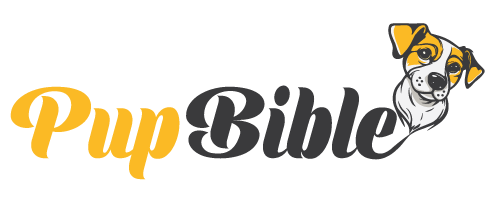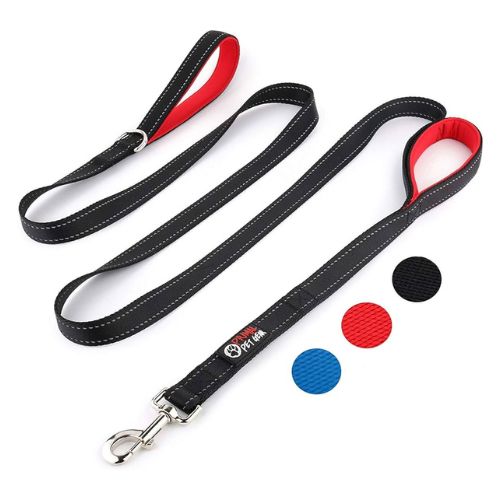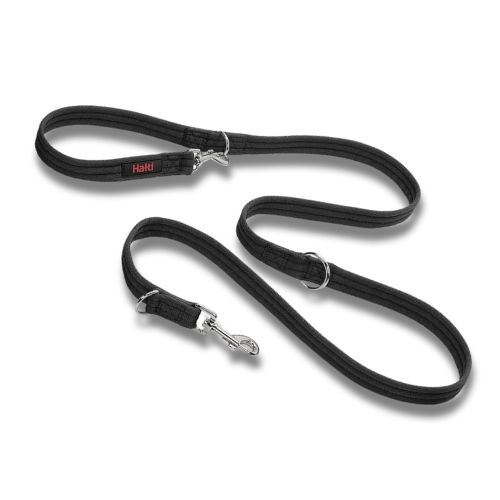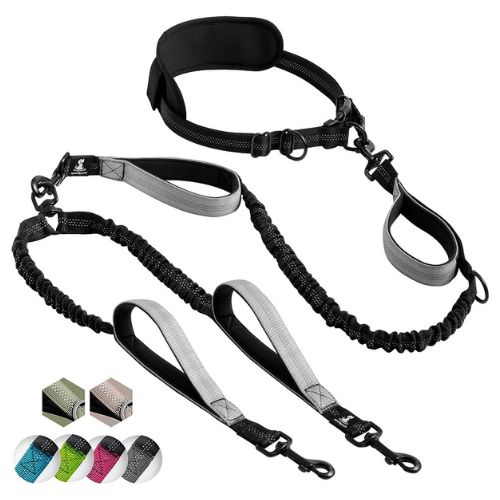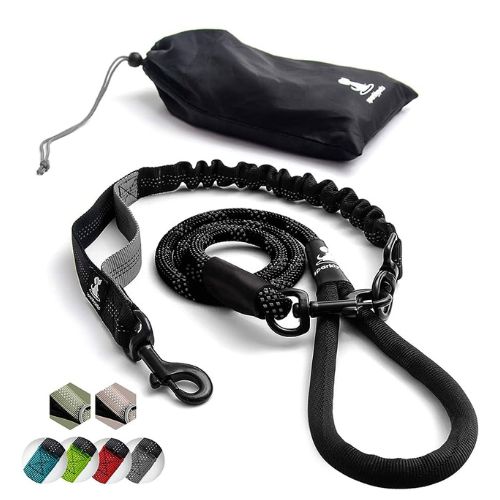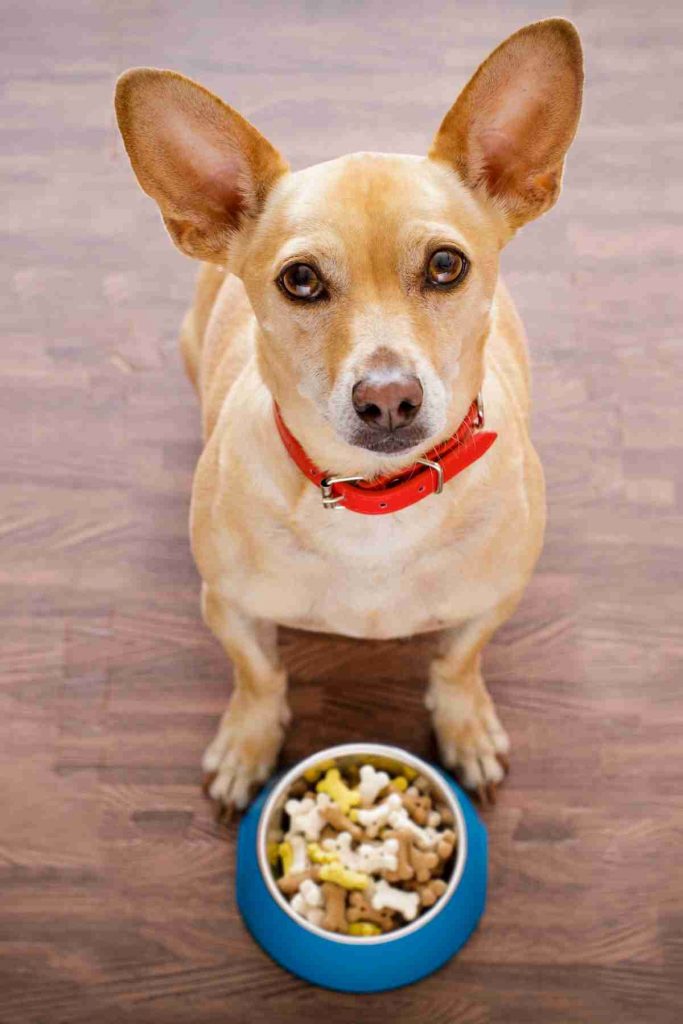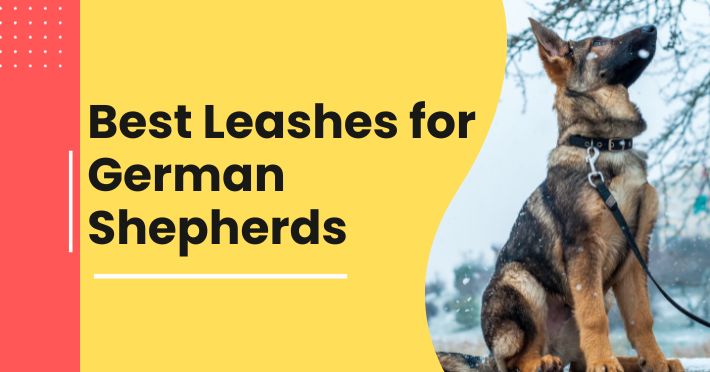
Quick Picks + Buying Snapshot
If you own a strong, active German Shepherd, you know a leash needs to do more than just look good. It must hold up to pulling, fit comfortably in your hand, and offer you control in different situations. Here are the top leash picks from PupBible, followed by what to look for when choosing your own.
| Product | Type | Best For | Length* | Price Tier* |
|---|---|---|---|---|
| Primal Pet Gear Dog Leash | Traditional / Dual-handle | Extra control & safety on walks | ~6 ft | Mid |
| Halti Training Lead (The Company of Animals) | Training / Double-ended | Correcting pullers & multi-attachment training | ~6-7 ft | Mid |
| Pet Dreamland Hands-Free Double Dog Leash | Hands-free / Coupler style | Walking two dogs at once or freeing up hands | Adjustable | Mid |
| Paw Lifestyles Extra Heavy Duty Dog Leash | Heavy-duty / rugged nylon | Adventures, rough terrain, frequent wear & tear | ~6 ft | Mid |
| SparklyPets Heavy Duty Rope Bungee Leash | Bungee / Shock-absorbing rope | Soften the impact of sudden lunges & pullers | Varies | Mid |
*Approximate and based on product specs in the article; price tier relative to similar leashes.
-
Best for pullers → Halti Training Lead (double-ended design helps reduce pulling)
-
Best budget (value) → SparklyPets Heavy Duty Rope Bungee Leash (strong build / shock absorbent, reasonable cost)
-
Best for training → Halti Training Lead (versatility & multiple clips)
-
Best heavy-duty → Paw Lifestyles Extra Heavy Duty Dog Leash (rugged, padded handle, strong clip)
Why the Best Leash for German Shepherds Matters
German Shepherds are powerful, smart, and energetic. While those traits make them wonderful companions, they also mean a leash that can’t keep up becomes more than just a nuisance—it can be dangerous. Here’s why choosing the right leash is urgent, and what’s at stake.
-
Strength & Power: A fully-grown GSD can weigh 70-90 lbs (or more), with strong jaw, neck, and body. When excited, startled, or chasing something, their instinct is to lunge. A weak leash or clip will fail under that force.
-
Energy & Speed: German Shepherds are high drive dogs. Their bursts of speed and sudden direction changes place huge stress on leash hardware. If your leash isn’t built for shock absorption (through materials, bungee sections, etc.) and strong connectors, it won’t last long.
-
Public Safety: A failing leash can result in your dog breaking free in traffic, running into other dogs or people, or causing accidents. According to the American Kennel Club, using a proper leash in public helps you control him around other dogs or people, protecting both your dog and others.
-
Legal & Liability Reasons: In many municipalities, leash laws are enforced. If your dog injures someone or damages property while off leash (or if leash fails), you may be held liable. Even beyond fines, there’s reputational risk and the possibility of being barred from public spaces, dog parks, or events by local ordinances or groups like the AKC, which mandates leashes in many public and event settings.
-
AKC Guidance & Best Practices: The AKC’s “Dog Leashes 101” emphasizes that leashes should be strong and well-made, with a sturdy metal clip to attach to collar or harness. American Kennel Club They also warn against using retractable leashes improperly (especially with dogs who pull), because when they snap tight, the sudden jerk can cause injury or catapult the handler.
Real-World Example
Imagine this: You’re walking your 2-year-old German Shepherd in the early morning. A squirrel darts across the sidewalk. Instinct kicks in, your dog lunges. The clip attaching your leash to the harness—cheap, thin metal—snaps. In a flash, your Shepherd bolts into the street. Cars swerve. You try to grab the leash, but it’s gone. Luckily, traffic is light and your dog is fine—but you’re shaken, and you realize just how small the margin was between disaster and luck.
When you add it all up—strength, energy, liability, public safety—the leash becomes more than just walking equipment. It’s a lifeline. Choosing a good one isn’t optional. It’s essential. Want me to pull together some key specs or standards to look for (clip materials, webbing strength, etc.) so you can judge leashes more confidently?
How to Choose the Best Leash for German Shepherds
Material & Why It Matters (Nylon vs Leather vs Biothane vs Chain)
German Shepherds are big dogs with strength, energy, and often exposure to rough terrain, weather, mud, etc. The material of the leash affects durability, comfort, maintenance, and safety. Below is a pros/cons table, with some community feedback, especially around Biothane, which has been trending.
| Material | Pros | Cons |
|---|---|---|
| Nylon (poly webbing, rope etc.) | Lightweight, inexpensive; many color/width options; soft texture; plenty of flexibility. | Absorbs water → mildew/odor; can fray; webbing edges may burn hands during yanks; weaker when wet; less resistant to abrasion. |
| Leather | Strong; ages well; good grip; less likely to fray; classic/stylish; certain leather becomes supple and strong with use. | Requires maintenance (conditioning, avoiding water/damp); can get stiff; heavier; expensive; in wet/muddy conditions it degrades faster. |
| Biothane® (synthetic coated webbing, polyester core + PVC/TPU or similar coating) | Waterproof, easy to clean (mud, smell, etc. wipe off easily); very durable; resists mildew/rot; often stiff at first but breaks in; many owners report lasting well. Reddit threads: users say with Biothane you don’t have to worry about odor or grime, and it holds up well even with large, pulling dogs. | Can be slippery when wet; texture/coating quality varies (cheap Biothane sometimes fails at rivets, weaker hardware); less flexibility at first; may feel stiff in cold weather; must watch rivets vs sewn attachment. |
| Chain (metal links) | Very chew-resistant; very strong; durable under heavy use; minimal degradation from sun/water. | Heavy; cold/hot metal is uncomfortable; rattling noise; less flexibility; metal can pinch fur or fingers; rust if poor quality metal; less comfortable for handler. |
Community notes on Biothane:
-
From r/service_dogs: many love Biothane for service work because “very durable and easy to clean,” no stink even after accidents.
-
From r/reactivedogs: some concern: when Biothane fails, it tends to fail suddenly, rather than gradual fraying that warns you.
Pro Tip: Pick a material based on the worst conditions your Shepherd will face (wet, muddy, rough terrain, chewing). If you choose Biothane, prioritize high-quality hardware and reinforced (sewn or bar-tack) connections.
Length Guide — When to Use 6 ft vs 12–30 ft Long Lines
Length of leash affects control, training opportunities, and safety. German Shepherds benefit from having varied leash lengths depending on context.
-
Everyday walks / city / crowded areas: A 4- to 6-foot leash is standard. Gives enough freedom to sniff, but keeps the Shepherd from getting too far ahead or entangled. Mendota Pet’s guide says 6 ft is the most common for daily walking.
-
Traffic leads / very close control: Short leads (12-18 in, 4 ft, leather or rope) are useful when you want the dog extremely close (e.g. stepping out of car, entering a building) or when you need control in tight spaces. Mendota Pet
-
Training / recall / obedience / field: Longer leads or “long lines” (15-30 ft or more) give the Shepherd room to roam but still let you control from a distance. Great for teaching recall, stay, scent work, off-leash transition. Mendota Pet offers “check cords” or long snap leads from 15-ft up to 50-ft for those training purposes.
-
Hiking / trails / open fields: Long leash or 10-20ft may be beneficial, so the dog can explore but you still maintain leash laws and safety. Just make sure you can quickly reel in slack.
Pro Tip: Get at least two leash lengths: one ~6 ft for daily walks & urban control, and one long line (15-30 ft) for training/off-leash practice & open areas.
Handle Design
The part you hold matters — comfort, safety, extra features.
-
Padded Handle: Helps reduce strain and protect your hand during sudden pulls or if the Shepherd lunges. A padded or lined handle is much more comfortable and less likely to cause rope burn or blisters.
-
Traffic Handle: A secondary handle close to the clip, often just a few inches from hardware. Great for tight control: you can use the traffic handle to keep the dog close in high-traffic situations, crosswalks, congested areas.
-
Dual-Handle / Extra Grip Loops: Some leashes have both a standard handle and an extra handle further down. Useful for large dogs: you use the lower handle when you need immediate control (e.g. when meeting other dogs or approaching hazards).
-
Hands-Free Designs: Waist belts or over-shoulder loops. Good for jogging, hiking, or emergencies. But need durable hardware, good quality, and you must be confident your Shepherd won’t pull you off-balance.
Pro Tip: If you frequently walk near traffic or meet other dogs, choose a leash with a traffic handle or dual-handle—it gives you control without the bulk of a shorter leash.
Hardware (Clips) — Types of Leash Clips
The clip (or clasp) is usually where failure happens first under heavy force. Here’s a breakdown of common clip types with pros/cons.
| Clip Type | Advantages | Disadvantages |
|---|---|---|
| Bolt Snap | Common; easy one-hand use; spring-loaded; inexpensive; works well under moderate loads. | Spring mechanism can weaken; accidental opening by bumping the “bolt”; not always rated for high loads; may corrode if low quality metal. |
| Trigger Snap (Lobster-style) | Usually more robust gate closure; better gate alignment; sometimes easier operation; tends to be safer under tension as lever must be pressed. | Bulkier; may be heavier; lever mechanism may get gunked; more moving parts to fail; more expensive. |
| Carabiner / Locking Carabiner | Very strong; locking types secure better; used in tactical / working dog gear; good for heavy pullers. | Heavier; may snag; gate locking needs checking; may be overkill in some situations; more expensive. |
| Quick-Release Clips | Fast to detach; good in emergencies; often used in travel or safety harness setups. | Could release accidentally if mechanism is weak; more moving parts; usually not as strong as a good bolt snap or carabiner; may be bulkier. |
Also consider hardware material: stainless steel and solid brass resist rust. Plated or cheaper metal may fail or corrode. Rivets vs sewn loops matter: some community feedback shows riveted hardware combined with cheap Biothane or webbing sometimes gives way at rivet points. Reddit+2Reddit+2
Pro Tip: Look for clips with a rated strength (or weight rating) and avoid anything that feels flimsy; if using heavy pullers, go for locking carabiner or high-quality trigger/bolt snap.
Specialty Leashes — Bungee / Shock-Absorb, Hands-Free, Couplers, Slip Leads
These are specialized leash styles useful in certain situations.
-
Bungee / Shock-Absorb Leashes: Contain a stretch section (elastic or bungee) to absorb sudden pulls. Great for reactive dogs, dogs that lunge, or handlers who want less jarring in the arm/shoulder. But the stretch can reduce your immediate control—if the dog lunges, there will be delayed tension. Not always ideal near traffic.
-
Hands-Free Leashes / Waist Leashes / Over-shoulder »: Lets you use both hands (carry items, steady toddler, etc.). Useful for jogging or when hands are busy. But risk: you can get pulled off balance; leash thickness, clip strength, and strong handle design become critical.
-
Couplers / Double-Dog Leashes: One leash, two clips. If you walk two dogs, couplers keep them from tangling. For GSD plus other dog, this can help. But tensions from both dogs can add up: hardware needs to handle combined pulling forces; also, if one dog misbehaves, control is compromised.
-
Slip Leads / Slip Leashes: A leash + collar in one, loops around the neck. Good for training, quick control, easy to use when switching between harness/collar. But misuse can cause too much pressure on neck; not always safe for strong pullers unless used correctly and briefly.
Pro Tip: Match specialty leash to situation (training vs casual), and always test it under controlled, light-force conditions before relying on it.
Sizing & Strength Ratings — Width, Tensile Strength Benchmarks
German Shepherds typically weigh between ~55-95 lbs (sometimes more), strong muscles, high drive. So sizing and strength matter a lot.
-
Width: A leash of at least 1″ (25-26 mm) width is recommended for large dogs, especially if they pull. Some owners use ¾″ for well-trained GSDs who don’t pull much. Community consensus (Reddit: r/OpenDogTraining etc.) shows ½″ Biothane can hold ~500 lbs pull; ¾″ more.
-
Tensile / Breaking Strength: Look for specifications when shopping—some tactical leashes list pull strength (e.g. 300-500 lb or more). As a rule, leash hardware + material should have breaking strength comfortably above your dog’s possible sudden load (a dog lunging, chasing, etc.). If the hardware is the weak link, even a strong webbing is useless.
-
Handle & Stitch Reinforcement: Where leash meets hardware (clip), where handle loop is formed—the stitching (or rivets) there must be strong. Patterns like box-stitch, box-X, bar-tack are used. rayallen.com+1
-
Weight of Leash vs Practical Handling: A super wide leash may be strong but might be too heavy for your hand or arm, especially on walks. Choose width/strength balance: enough to handle strain, but still manageable to carry and use.
Pro Tip: Aim for leash width & clip strength that gives at least 2-3× more breaking strength than your GSD’s weight (especially for pullers). 1″ width is a good benchmark.
Chewing / Escape-Proof Options
Some German Shepherds chew, or try to slip collars / escape harnesses / leash hardware. If that’s a concern, here are materials and designs to help:
-
Chain sections / chain leashes/collars: Very chew-resistant; dogs tend to dislike chewing chain. But chain is heavy and cold; needs good quality metal to avoid rust or sharp edges.
-
Biothane, especially coated versions: Many owners report the outer coating resists chew marks better than plain nylon or rope, and cleans easily. In Reddit threads: even after daily outdoor use, Biothane long lines retain good condition despite mud, grime, even light chewing.
-
Locking hardware / carabiners: Use carabiners or clips with locking mechanisms to prevent accidental release. Cheap snap hooks sometimes open under pressure or due to wear. Hardware quality is frequently the weak spot.
-
Slip-resistant designs: For collars/harnesses that dogs can slip out of, use harnesses or collars that are escape-proof; combine with strong leash attachment to harness instead of just collar.
Pro Tip: If your GSD is a chewer or escape artist, prioritize chain or heavy-duty Biothane plus locking hardware; inspect regularly and replace at first sign of damage.
Types of Leashes: Real Use Cases for German Shepherds
German Shepherds thrive when matched with the right gear for the situation. The “best” leash isn’t one-size-fits-all—it depends on the scenario. Below are common use cases with recommendations, practical tips, and quick decision boxes.
Daily Walks
For everyday walks around the neighborhood or city, a 6-foot leash is the gold standard. This length provides just enough slack for your Shepherd to sniff and explore without giving them too much freedom. Since GSDs are powerful dogs, look for dual-handle or traffic-handle leashes. These let you shorten the lead instantly when crossing streets, passing distractions, or walking through crowded areas.
Materials like nylon, leather, or Biothane work well, provided the hardware is heavy-duty and handles are padded. A wide, 1-inch strap offers better control than narrow leads. For stronger pullers, pair with a front-clip harness for added safety.
If you want better control on daily walks, choose a 6-ft leash with a traffic handle.
Training & Recall
When teaching recall, “stay,” or long-distance commands, you’ll need a 15–30 ft long line. Long lines allow your Shepherd to roam while keeping you legally compliant with leash laws. Trainers often recommend Mendota Pet’s check cords or Biothane long lines because they provide enough length without tangling too easily.
A sturdy clip is essential, as recall training often involves sudden lunges when the dog runs back toward you. If you train in muddy or grassy fields, Biothane is ideal—it wipes clean and doesn’t hold odor.
If you want to train recall safely, choose a 15–30 ft long line.
Hiking & Adventures
For trails, camping, or off-road adventures, you need a leash that’s durable, weather-resistant, and secure. Biothane or heavy-duty nylon leashes are popular because they handle mud, rain, and UV exposure without degrading. Pair these with a locking carabiner clip—rock-climbing grade carabiners are especially reliable for preventing accidental unclipping on the trail.
A 6–10 ft leash is a good balance for hiking: long enough for your dog to explore, short enough for quick control if you encounter wildlife, bikers, or other dogs. Some owners prefer hands-free waist leashes for stability, but with a strong Shepherd, use only if you’re confident in your footing.
If you want security on trails, choose a Biothane or nylon leash with a locking carabiner.
Working & Tactical Use
German Shepherds are often used as service, police, or protection dogs, and working contexts demand leashes that support precision and strength. Leather leashes are favored for this role—they’re strong, comfortable in hand, and become more supple over time. A double-clip design (two attachment points) is also common in working/tactical leashes, offering more control and versatility for different harness setups.
Handlers in working roles often switch between short, close-control lengths and longer training leads, so investing in high-quality hardware and stitching is essential. Brass or stainless steel clips are preferred for durability.
If you want a professional-grade leash, choose leather with a double clip.
Puppy Starter Leashes
Puppy German Shepherds need a softer introduction to leash life. Heavy-duty tactical leashes are overkill at this stage. Instead, choose a lightweight 4–6 ft leash, ideally in nylon or soft Biothane. Puppies benefit from shorter sessions, so comfort in your hands is key as you’ll be correcting and redirecting often.
Since young GSDs are still learning leash manners, dual-handle options can help you quickly regain control without overwhelming the pup. Always pair with a comfortable harness to avoid too much strain on their developing necks.
If you want to start leash training early, choose a lightweight 4–6 ft leash.
For Chewers
Some German Shepherds chew their leash, either out of boredom or drive. In these cases, durability matters most. Chain leashes discourage chewing since the metal is uncomfortable on teeth. Alternatively, Biothane leashes resist wear far better than nylon and are easier to clean. Pair with locking carabiner hardware to prevent escape if your Shepherd also tries to slip collars.
Avoid rope or thin nylon if your GSD is a dedicated chewer—they’ll shred it quickly. A thicker width (1″) combined with chew-resistant material provides the best balance of control and safety.
If your dog chews leashes, choose chain or Biothane with a locking clip.
Final Takeaway
Every scenario—whether walking downtown, training recall, hiking, or working—calls for a different tool. Instead of buying one “do-it-all” leash, it’s smarter to build a small toolkit: one for daily control, one for training, and one for special situations like hiking or chewing.
That way, you’re never caught with the wrong gear when your German Shepherd’s strength, energy, or environment tests your setup.
Quick Scenario Comparison: Best Leash Types for German Shepherds
| Scenario | Leash Type | Best Material | Recommended Length |
|---|---|---|---|
| Daily Walks | Standard leash w/ traffic handle | Nylon, Leather, Biothane | 6 ft |
| Training / Recall | Long line / check cord | Biothane or Nylon | 15–30 ft |
| Hiking / Adventures | Heavy-duty leash w/ locking carabiner | Biothane, Nylon | 6–10 ft |
| Working / Tactical | Double-clip, close-control | Leather | 4–6 ft |
| Puppy Starter | Lightweight leash | Nylon, Soft Biothane | 4–6 ft |
| Chewers | Chain or Biothane w/ locking hardware | Chain, Biothane | 6 ft |
-
If you want better control on daily walks → choose a 6-ft leash with a traffic handle.
-
If you want to train recall safely → choose a 15–30 ft long line.
-
If you want security on trails → choose a Biothane or nylon leash with a locking carabiner.
-
If you want a professional-grade leash → choose leather with a double clip.
-
If you want to start leash training early → choose a lightweight 4–6 ft leash.
-
If your dog chews leashes → choose chain or Biothane with a locking clip.
Types of Leash Clips
For a German Shepherd, the leash clip is often the true weak point. Even the strongest leash strap is useless if the clip fails under pressure. Understanding clip types helps you match strength, usability, and safety to your dog’s needs.
Common Clip Types
Here are the four most popular leash clips, with quick visuals and best-use notes.
1. Bolt Snap
The classic clip with a spring-loaded bolt that slides back. Easy to find, inexpensive, and works for many daily-walk setups.
-
Weakness: springs may wear out, and cheaper versions can pop open with sudden impact.
2. Trigger Snap
-
Weakness: bulkier than bolt snaps, moving parts can jam with dirt.
3. Carabiner / Locking Carabiner
-
Weakness: heavier, can snag; requires handler to lock gate properly.
4. Quick-Release Clip
-
Weakness: higher risk of accidental release; best reserved for advanced users or controlled contexts.
Comparison Table
| Clip Type | Strength | Ease of Use | Best For |
|---|---|---|---|
| Bolt Snap | Moderate (good for everyday) | Very easy one-hand use | Standard daily walks |
| Trigger Snap | Higher (stronger spring/closure) | Easy, but bulkier | Training, moderate pullers |
| Carabiner (Locking) | Very high (rock-climbing grade rated) | Moderate (need to screw/lock) | Strong pullers, hiking, tactical use |
| Quick-Release | Variable (depends on build) | Very fast | Working/service contexts, emergencies |
Testing a Leash Clip at Home
Before trusting any clip with a 70–90 lb German Shepherd, do some basic checks:
-
Check Manufacturer Rating: Look for a listed tensile strength or load rating. Many quality retailers (e.g., Ray Allen, Ruffwear, climbing gear suppliers) specify break strength. Aim for at least 2–3× your dog’s body weight.
-
Rotate and Snap: Open/close the clip repeatedly. Does it feel gritty, loose, or too soft? Springs should snap shut firmly and consistently.
-
Inspect Machining: Examine the gate and body. Rough edges, thin plating, or poorly aligned parts are signs of cheap production. Quality hardware uses brass, stainless steel, or climbing-rated aluminum.
-
Stress Test: Attach the clip to a secure anchor (fence post, eye bolt), then pull hard at different angles. Rotate the clip to test if it twists open under tension.
-
Field Test: Try in a low-risk environment first (backyard, fenced field) before relying on it in traffic or busy areas.
According to best-practice guides from working-dog suppliers like Ray Allen, hardware and stitching are the first places to fail. High-quality gear is rated and tested—cheaper imports often aren’t.
✅ Pro Tip: For a strong, active German Shepherd, locking carabiner clips offer the best balance of strength and security. If you prefer lighter gear for daily use, choose a trigger snap over a cheap bolt snap.
The 5 Best Leashes for German Shepherds
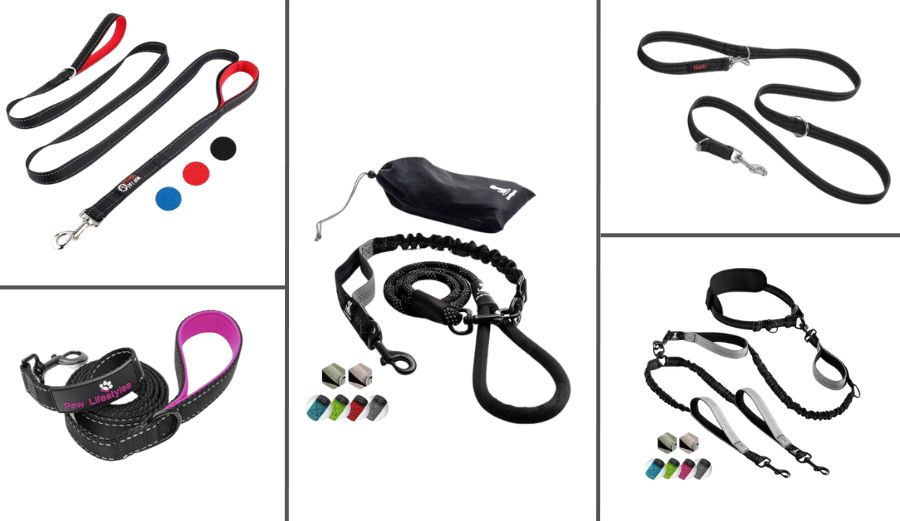
Listen, if you own a German Shepherd, you already know the deal. These dogs are smart, loyal, and absolute powerhouses. They’re not your average lapdog—you need gear that can actually keep up with them. And here’s the truth: the wrong leash can mess up your walks, stress you out, and even put people around you at risk.
That’s why finding the best leash for German Shepherds isn’t just about style—it’s about strength, control, and safety. The market is flooded with options, and let’s be real, most of them won’t hold up to a 90-pound GSD that decides to lunge.
So here’s what we did: we cut through the noise and rounded up the top 5 German Shepherd leashes based on what actually matters—durability, handling, and real-world performance. No fluff, no gimmicks. Just leashes that get the job done.
The Primal Pet Gear Dog Leash is built with medium to large breeds in mind—making it a strong candidate for German Shepherd owners who need both durability and control. Its standout feature is the dual-handle design, giving you the option of a standard 6-foot walk or quick, close control in high-traffic areas.
Pros
-
Two handles: one at the end, one near the clip for instant control.
-
Soft neoprene grips: reduces hand strain during long walks or sudden pulls.
-
Heavy-duty clip: designed to withstand strong lunges.
-
1-year replacement warranty: solid reassurance for everyday use.
Cons
-
Not sized for small breeds.
-
Only available in orange, limiting style choices.
Best For
Owners of medium and large dogs (German Shepherds, Labs, Huskies) who want extra control in busy environments like crosswalks, crowded parks, or training sessions.
Expert Verdict:
The Primal Pet Gear Dog Leash balances strength, comfort, and handler control in one package. If you need a reliable everyday leash with built-in traffic safety, this model stands out among standard nylon leashes.
The Company of Animals Halti Training Lead is a versatile option designed with training and control in mind. Paired with a Halti Headcollar or Harness, it’s a favorite among trainers for tackling pulling behavior in large, strong breeds like German Shepherds.
Pros
-
7 different uses: double-ended, hands-free, tethering, and more.
-
Lightweight yet durable nylon for everyday walks and training.
-
Multiple clips allow varied connection points for flexibility.
-
Widely recommended by trainers and pet parents worldwide.
-
Works especially well for anti-pull training when paired with Halti gear.
Cons
-
Less suited for small dogs.
-
Limited to basic color options.
Best For
Owners who want one leash that can do it all—from loose-leash walking practice to hands-free setups during training. Particularly effective for German Shepherds that pull, when combined with a Halti Headcollar or Harness.
Expert Verdict:
The Halti Training Lead stands out for its versatility and trainer-approved design. It’s more than just a leash—it’s a flexible training tool. If you’re looking for an all-in-one solution for pulling control and everyday walks, this lead is an excellent choice.
The Pet Dreamland Hands-Free Double Dog Leash is designed for active owners who want to walk two large dogs comfortably without wrist or shoulder strain. With shock-absorbing bungee cords and a tangle-free coupler, it balances freedom of movement with reliable control.
Pros
-
Hands-free design reduces stress on arms, wrists, and shoulders.
-
360° swivel coupler prevents tangles as dogs move around.
-
Four shock-absorbing bungees cushion pulling and teach calmer walking.
-
Adjustable length for versatility across different walking styles.
-
Padded handle for extra comfort when close control is needed.
Cons
-
Not suitable for small dogs (recommended for 35–150 lbs each).
Best For
Owners of two medium-to-large dogs (German Shepherds, Labs, Huskies) who want a safer, more ergonomic way to walk both at once—especially for active lifestyles, jogging, or long hikes.
Expert Verdict:
The Pet Dreamland Double Dog Leash makes two-dog walks safer, smoother, and more comfortable. Its shock-absorbing system helps manage pulling, while the hands-free waist design gives you balance and control. For households with strong, energetic breeds, this leash is a standout solution.
The Paw Lifestyles Extra Heavy Duty Dog Leash is built for strength and comfort, making it a solid option for owners of energetic, large-breed dogs like German Shepherds. With reflective stitching, a padded handle, and rugged nylon, it’s designed to perform on daily walks, runs, and hikes.
Pros
-
Heavy-duty durability with tightly woven nylon.
-
Padded neoprene handle for comfortable grip.
-
Reflective threading improves visibility at night.
-
Lightweight yet strong—easy to use without bulk.
-
Includes D-ring for accessories (waste bag, keys, etc.).
-
Backed by a 100% money-back guarantee.
Cons
-
Not chew-proof (supervised use recommended).
Best For
Active owners who need a reliable, all-purpose leash for large or strong breeds. Ideal for everyday walks, jogging, or outdoor adventures where durability and safety matter most.
Expert Verdict:
The Paw Lifestyles Extra Heavy Duty Dog Leash strikes a great balance of strength, comfort, and safety. While not chew-resistant, it’s more than capable of handling the pulling power of a German Shepherd. The reflective threading and padded handle make it especially useful for longer walks and night outings.
The SparklyPets Heavy Duty Rope Bungee Leash is built for strong, energetic dogs that tend to pull. Combining a braided nylon rope with elastic bungee cushioning, it helps absorb shock and gives owners more control during walks or training sessions.
Pros
-
Anti-pulling design reduces strain on both dog and handler.
-
Durable build with thick rope, metallic hook, and reinforced leather joints.
-
Shock-absorbing bungee eases sudden pulls.
-
Reflective stitching for nighttime safety.
-
Stylish look available in multiple colors.
Cons
-
Too bulky for small dogs (best for medium to large breeds).
Best For
German Shepherds, Huskies, and other large dogs with strong pulling habits. A solid choice for leash training, daily walks, or handling reactive dogs that lunge.
Expert Verdict:
The SparklyPets Rope Bungee Leash combines strength, style, and function. Its bungee section makes walks smoother and reduces tugging fatigue, while the sturdy construction ensures long-term reliability. For owners dealing with strong pullers, this leash is both practical and stylish.
Leash Training: Step-by-Step Program (6 Weeks)
German Shepherds are intelligent and energetic—great traits for training, but they can also pull hard if not guided correctly. A structured leash-training program helps channel their drive into calm, controlled walking. This plan uses 5–10 minute daily sessions, gradually layering skills over 6 weeks.
Week 1: Leash Tolerance (Getting Comfortable)
Goal: Make the leash/harness a positive, normal part of life.
-
Introduce the harness and leash indoors.
-
Clip it on and let your pup drag it around under supervision.
-
Pair with treats, praise, or a favorite toy so the leash = fun.
-
Keep sessions short and stress-free.
Trainer Tip: The AKC notes that early positive exposure reduces leash resistance later.
Week 2: Short Walks + Reward
Goal: Build association between walking by your side and getting rewarded.
-
Begin 3–5 minute indoor or backyard walks.
-
Every few steps of calm walking → reward with small treats.
-
Mark the behavior (“Yes!” or clicker) before giving the reward.
-
End before your Shepherd gets restless.
Pro Tip: Use pea-sized soft treats—quick to deliver and easy to eat.
Week 3: Loose-Leash Basics
Goal: Introduce the idea that slack = reward, pulling = no progress.
-
Hold leash in a “J” shape (slack, not tight).
-
If the dog pulls → stop walking. Wait until leash slackens → then move.
-
Reward when leash stays loose for 3–5 steps.
-
Practice in low-distraction environments first.
Trainer Tip: Many trainers emphasize consistency—never let pulling get rewarded with forward movement.
Week 4: Dealing With Pulling
Goal: Teach alternatives to lunging.
-
Use redirection: when the dog pulls, turn in the opposite direction.
-
Reward when they reorient and follow.
-
Introduce traffic-handle practice: keep them close at crosswalks or crowded areas.
-
Add brief 5-minute outdoor sessions in calm neighborhoods.
Pro Tip: Avoid retractable leashes here—the AKC warns they reinforce pulling.
Week 5: Distraction Training
Goal: Proof loose-leash skills against real-world triggers.
-
Gradually introduce mild distractions (toys, other dogs at distance).
-
Use higher-value rewards (chicken, cheese).
-
Practice “Watch Me” cue for eye contact when distracted.
-
Keep sessions short, 3–5 minutes per distraction type.
Trainer Tip: Increase distractions slowly—distance before intensity.
Week 6: Recall Integration With Long Line
Goal: Combine leash manners with recall control.
-
Switch to a 15–30 ft long line.
-
Practice recalls: call the dog → reward when they return on leash.
-
Mix leash-walking with recall games in parks/fields.
-
End every session with success—don’t push too far.
Pro Tip: Long lines allow recall practice while staying compliant with leash laws.
Final Takeaway
In just 6 weeks, you’ll build from leash tolerance to reliable loose-leash walking, even under distractions. Remember: short, daily, positive sessions beat long, frustrating ones. With patience, your German Shepherd will see the leash not as a restraint, but as a signal to work in sync with you.
Gear Pairings: Collars, Harnesses, and Training Tools for German Shepherds
A leash is only as effective as the gear you clip it to. Choosing the right pairing—collar, harness, or specialty tool—can make training smoother and safer for both you and your German Shepherd.
Harnesses: Control Without Strain
Harnesses spread pressure across the chest and shoulders, reducing risk of tracheal injury. For powerful dogs like GSDs, this can prevent long-term neck issues.
-
Front-clip harnesses (e.g., Easy Walk) discourage pulling by redirecting momentum.
-
Back-clip harnesses are comfortable but can encourage pulling in strong dogs.
-
Dual-clip harnesses allow flexible training setups.
🔎 Controversy: Some trainers argue front-clip harnesses restrict shoulder movement if misused, potentially altering gait. Communities on Reddit’s r/dogs and r/germanshepherds debate this often—many owners prefer dual-clip harnesses for versatility.
Collars: Traditional but Limited
-
Flat collars are the most common—simple, lightweight, and good for dogs with established leash manners.
-
Martingale collars tighten slightly under tension, offering extra security for escape-prone dogs without choking.
-
Prong collars are divisive. Advocates (e.g., certain working-dog trainers) say they provide clear feedback for large, driven breeds; opponents (AKC and many positive-reinforcement communities) caution about misuse and stress.
Best Use: Stick to flat or martingale collars for everyday use; consider advanced tools only under professional guidance.
Headcollars: Precision Control
Headcollars (e.g., Gentle Leader, Halti) give maximum steering ability—similar to how halters guide horses. They can reduce lunging dramatically, especially in urban settings.
-
Pros: Excellent for handlers needing extra leverage.
-
Cons: Many dogs dislike the feel, and improper use can strain the neck. Requires careful acclimation and positive reinforcement.
No-Pull Tools: Helpful or Harmful?
-
Front-clip harnesses and headcollars fall under the “no-pull” category.
-
Some trainers argue they are “management tools, not teaching tools”—helpful for short-term safety but not a substitute for consistent leash training.
-
Long-term reliance without training may mask, not fix, pulling.
Matching Tools to Purpose
-
Daily walks: Flat collar + dual-clip harness.
-
Training sessions: Front-clip harness or headcollar with high-value rewards.
-
Strong pullers / safety concerns: Locking carabiner leash + martingale collar or tactical harness.
-
Escape artists: Martingale or Y-style harness with secure fit.
✅ Pro Tip: Always pair strong leashes with equally strong hardware—cheap plastic buckles or weak clips are often the first failure point, not the leash itself.
Safety, Legal & Etiquette
Walking a German Shepherd is not just about training—it’s also about safety, compliance, and respect for others. Strong, energetic dogs demand thoughtful leash practices to protect you, your dog, and the public.
Leash Laws: Know Before You Go
Most U.S. cities and counties require dogs to be leashed in public areas. Penalties for violations can range from small fines to legal liability if your dog causes an accident. Because leash laws vary, the best approach is simple: Google “[your city] + leash law” before heading out. Many municipal websites provide up-to-date ordinances.
🔎 Example: The American Kennel Club emphasizes that leashing isn’t just legal compliance—it’s also a cornerstone of responsible ownership and public safety.
Public Etiquette
A 90 lb German Shepherd can intimidate strangers, even if friendly. Good etiquette reduces tension:
-
Keep your dog at your side, not leading several feet ahead.
-
Use a traffic handle or shorten the leash in crowded areas.
-
Always ask before letting your dog greet another person or pet.
-
Pick up after your dog—no exceptions.
These small steps signal responsibility and create positive impressions of the breed.
Handler Safety
How you hold the leash matters:
-
Thread the loop around your wrist once, then grip firmly with your hand. Avoid wrapping around fingers—this can cause injury if your dog lunges.
-
Keep slack in a “J” shape, not a tight line. Tension encourages pulling.
-
Stand with a stable base: knees bent slightly, leash hand close to your core.
Emergency Situations
Loose dogs are a common hazard. If one approaches:
-
Stay calm, avoid yelling, and don’t drop the leash.
-
Step between your dog and the oncoming dog.
-
Use your leash, foot, or a firm “Stop!” to create space.
-
If available, carry a small deterrent (like a pet-safe spray or umbrella) for backup.
✅ Pro Tip: Practicing leash drills in safe areas before venturing into busy neighborhoods prepares you and your Shepherd for real-world surprises.
Final Verdict: Choosing the Best Leash for Your German Shepherd
At the end of the day, the best leash for a German Shepherd is the one that matches your dog’s strength, your walking style, and your training goals. Whether it’s a sturdy 6-foot daily leash, a Biothane long line for recall work, or a heavy-duty locking carabiner clip for hiking, the right choice keeps both you and your dog safe.
The process is simple:
-
Pick your category (daily walks, training, hiking, or chewing).
-
Read our in-depth reviews of the top options in that category.
-
Train consistently—because no leash works without practice and positive reinforcement.
A quality leash is more than gear—it’s peace of mind, public safety, and a key training partner. Invest wisely, and your German Shepherd will reward you with smoother walks, better manners, and a stronger bond.
👉 Micro-CTA: Want a printable guide to stay on track? Sign up for our newsletter and get the Leash Training Checklist PDF—a 6-week step-by-step plan to build calm, confident leash skills.
FAQs: German Shepherd Leash Questions
1. What length leash for a German Shepherd?
A 6-foot leash is ideal for everyday walks with a German Shepherd. For recall or training, use a 15–30 ft long line.
👉 Standard walks need control, while long lines build safe freedom in training.
2. Are retractable leashes safe for large dogs?
Retractable leashes are not recommended for German Shepherds. They can snap under force, cause rope burns, and encourage pulling.
👉 Trainers and the AKC advise fixed-length leashes for strong breeds, especially in public spaces.
3. Should GSDs wear harness or collar?
A harness is safer for most German Shepherds, while a collar can be used for trained, calm walkers.
👉 Harnesses reduce neck strain and offer better control. Collars are best for ID tags and backup.
4. How wide should a leash be for a German Shepherd?
Choose a leash that is at least 1 inch wide for strength and durability.
👉 Narrower leashes may fray or snap under 80–90 lbs of pulling force, especially with energetic GSDs.
5. How to stop a German Shepherd from pulling on a leash?
Stop walking when your dog pulls, reward when the leash slackens, and redirect with turns.
👉 Consistency teaches that pulling doesn’t lead forward. Harnesses with front clips can help during training.
6. What’s the best leash material for German Shepherds?
Biothane and leather are top choices for GSDs. Biothane is waterproof and durable, while leather softens with age.
👉 Nylon is affordable but may fray faster under heavy use.
7. Can a German Shepherd chew through a leash?
Yes—especially nylon. Biothane or chain leashes are better for chewers.
👉 Many owners use a carabiner lock for escape-proof security.
8. Do German Shepherds need special leashes?
Not “special,” but they need strong, wide, and secure leashes rated for large breeds.
👉 Cheap clips and thin nylon straps often fail under sudden lunges.
9. Are slip leads good for German Shepherds?
Slip leads can be useful for training or quick control but require experience.
👉 Misuse can cause pressure injuries. They’re best for professional or short-term scenarios.
10. Can I use a long line in public?
Yes, but only in safe open spaces—never on sidewalks or crowded parks.
👉 Long lines give recall practice while still complying with leash laws, but they require handler awareness.
Resources, Tests & Community Feedback
Real data helps cut through marketing hype. Below are expert test labs, community feedback, and resources from trusted organizations.
Expert Laboratory & Retailer Tests
-
TechGearLab’s 2025 leash tests evaluated 10 leashes (e.g. Max & Neo, Ruffwear, Petsafe). They ranked the Max & Neo Triple Handle leash “Best Overall” for durability, multiple handles, comfort, and ease of control under load.
-
From GearJunkie, a tester used the Front Range Dog Leash—with German Shepherd mixes pulling, chewing, and rough use—for two months. It survived well: “looks as good today as it did on day one.” The clasp and padded handles held up particularly well.
-
AKC’s “Dog Leashes 101: Choosing the Right Dog Leash” provides foundational guidance: for large dogs and those who pull, use thicker, wider, high-quality leashes; avoid retractable ones for untrained or strong dogs. They also recommend beginning leash training with a 4-6-foot standard leash.
Community Feedback (Reddit, Forums, User Reviews)
-
On r/germanshepherds, one user writes: “I like leashes made of Biothane. They tend to be very strong and the texture of them is leather-like and grippy in any weather.”
-
Another owner: “Woven nylon leashes work well for Sam. He wore out the padded handle on one. He used to pull pretty hard. Now it’s more of a steady pull … I think they rate them for dog size.” — demonstrates material wear and importance of rating width/hardware.
-
From German Shepherd forums: a user reports their 2-inch nylon collar “has held up well over 2 years through snow, mud, swimming and everything else. The color faded But works like new.”
Research & Safety Studies
-
A recent study compared pulling force on dogs wearing neck collars vs chest harnesses under standardized pulls. Found that neck collars often concentrate force dangerously on throat; chest harnesses distribute force more safely. Useful when selecting how leash connects to the dog.
Why This Matters
These test results and user reports confirm:
-
Material & hardware matter — poor hardware, weak stitching, or thin webbing fail early.
-
Real-use (with strong breeds, wet/muddy conditions, etc.) exposes weak points that marketing often hides.
-
AKC guidance and lab tests both discourage retractable leashes for big, strong dogs unless the dog is very well trained.
Community Engagement & Fresh Content
We’d love to showcase your experience! If you have a leash + German Shepherd, consider:
-
Submitting short reviews or photos of your leash after months of use. What has held up? What failed?
-
Sharing specific details: material, hand comfort, hardware strength, width, whether it pulled, whether it got chewed, whether hardware rusted, etc.
Your user-generated content helps everyone: builds trust, provides real-world validation, and helps refresh content to stay current and relevant.
